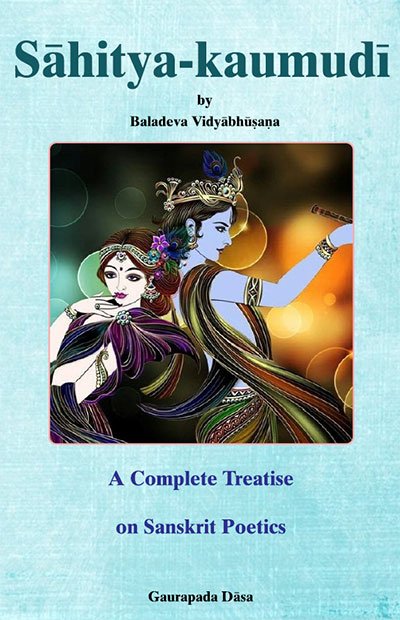Sahitya-kaumudi by Baladeva Vidyabhushana
by Gaurapada Dāsa | 2015 | 234,703 words
Baladeva Vidyabhusana’s Sahitya-kaumudi covers all aspects of poetical theory except the topic of dramaturgy. All the definitions of poetical concepts are taken from Mammata’s Kavya-prakasha, the most authoritative work on Sanskrit poetical rhetoric. Baladeva Vidyabhushana added the eleventh chapter, where he expounds additional ornaments from Visv...
Text 4.1
अथ दोष-गुणालङ्कारान् परत्र वक्षयन् पूर्वं तद्-आश्रयभूतान् काव्य-भेदान् प्रपञ्चयति,
atha doṣa-guṇālaṅkārān paratra vakṣayan pūrvaṃ tad-āśrayabhūtān kāvya-bhedān prapañcayati,
Now, to describe the literary faults (doṣa), the literary qualities (guṇa) and the ornaments (alaṅkāra), in other chapters, at first he elaborates upon the varieties of poetry which are their basis (this chapter treats of first-rate poetry):
avivakṣita-vācyo yas tatra vācyaṃ bhaved dhvanau |
arthāntare saṅkramitam atyantaṃ vā tiraskṛtam ||4.24||
avivakṣita-vācyaḥ—called avivakṣita-vācya (“whose literal sense is not meant to be expressed”); yaḥ—which [first-rate implied sense]; tatra—when that (the dhvani); vācyam—the literal sense; bhavet—becomes; dhvanau—when a first-rate implied sense occurs; artha-antare—into another meaning; saṅkramitam—changed; atyantam—completely; vā—or; tiraskṛtam—obliterated (“removed”).
When the dhvani is avivakṣita-vācya (the literal sense is not meant to be expressed), the literal sense either transforms into another sense (arthāntara-saṅkramita) or becomes completely obliterated (atyanta-tiraskṛta).
uttama-kāvya-rūpo dhvanir dvi-bhedaḥ, lakṣaṇā-mūlo'bhidhā-mūlaś ceti tayor ādyaṃ vibhajati, avivakṣiteti. lakṣaṇāmūlatvād avivakṣitaṃ bādhitaṃ vācyaṃ yatra tasminn avivakṣita-vācyākhye dhvanau vācyaṃ dvedhā, upādāna-lakṣaṇāyāṃ satyām anupayogād arthāntare pariṇatam, lakṣaṇa-lakṣaṇāyāṃ tv atyantānupapatter atyanta-tiraskṛtaṃ ca.
The dhvani which is the form of first-rate poetry (uttama-kāvya) has two varieties: One is based on Indication (lakṣaṇā-mūla) and the other on Denotation (abhidhā-mūla). Of the two, in this definitional verse he subdivides the first one.
When the first-rate implied sense known as avivakṣita-vācya, wherein the literal sense is not meant to be expressed since the dhvani is based on Indication, takes place, in other words the literal sense is incompatible, the literal meaning is analyzed in one of two ways: (1) When Inclusive Indication occurs (upādāna-lakṣaṇā, also called ajahat-svārthā), the literal meaning is not really significant, therefore it transforms into another sense (arthāntara-saṅkramita-vācya), and (2) When Exclusive Indication occurs (lakṣaṇalakṣaṇā, also called jahat-svārthā), the literal meaning gets completely obliterated (atyanta-tiraskṛta-vācya) because it is completely logically inconsistent.
Commentary:
Those two subcategories—arthāntara-saṅkramita-vācya dhvani and atyanta-tiraskṛta-vācya dhvani—were referred to previously (2.16). They constitute lakṣaṇā-mūlā śābdī vyañjanā (Suggestiveness based on Indication and related to a word or words) (2.23).
Moreover, the order of the chapters in Kāvya-prakāśa is the same in Sāhitya-kaumudī. It follows Mammaṭa’s definition of poetry: tad adoṣau śabdārthau sa-guṇāv analaṅkṛtī punaḥ kvāpi (1.6). Words and meanings were expounded first since they are the subject of that sentence. This chapter and the next two correspond to the aforesaid three kinds of poetry (dhvani, guṇī-bhūta-vyaṅgya, and citra) (1.8-12). The subsequent chapters treat of doṣa (literary fault) (7), guṇa (literary quality) (8), and alaṅkāra (ornament) (9-10).
In technical terms, there are two kinds of implied meanings: dhvani (first-rate implied sense) and guṇī-bhūta-vyaṅgya (second-rate implied sense). Ānandavardhana writes: mukhyatayā prakāśamāno vyaṅgyo’rtho dhvaner ātmā, “An implied sense which manifests in terms of being prominent is the soul of dhvani-kāvya (first-rate poetry)” (Dhvanyāloka 2.2). Sometimes the word dhvani only means “implied sense”,[1] and it is up to the reader to determine whether the implied sense is first-rate or second-rate. In this chapter, the term dhvani only signifies “first-rate implied sense”. This means the implied sense is more astonishing than the literal sense of the text. By contrast, when the implied sense is not more beautiful than the literal meaning of the text, it is second-rate.[2] The subcategories in this chapter also apply to second-rate poetry (5.16). In addition, there are eight broad varieties of second-rate implied sense (5.1).
To clarify that the term dhvani in the above sūtra only means “first-rate implied sense,” Mammaṭa elaborates: lakṣaṇā-mūlagūḍha-vyaṅgya-prādhānye saty eva, avivakṣitaṃ vācyaṃ yatra sa dhvanau ity anuvādād dhvanir iti jñeyaḥ, “On account of the mention of dhvanau here, when the predominant element in the sentence is a subtle implied sense based on Indication, that is a dhvani in regard to which the literal sense is not intended to be expressed” (Kāvya-prakāśa 4.24). The commentators explain that the word gūḍha (subtle) in Mammaṭa’s elaboration serves to exclude a second-rate implied sense. In this regard, the term agūḍha (unsubtle) is one of the eight kinds of second-rate poetry (5.1). The same two categories (arthāntara-saṅkramita-vācya dhvani and atyanta-tiraskṛta-vācya dhvani) are also found in second-rate poetry (5.2). The terms gūḍha and agūḍha were mentioned earlier as the two kinds of implied meanings in purposeful figurative usage (2.18).
Footnotes and references:
[1]:
vyaṅgyam eva dhvaniḥ (Alaṅkāra-kaustubha 1.14).
